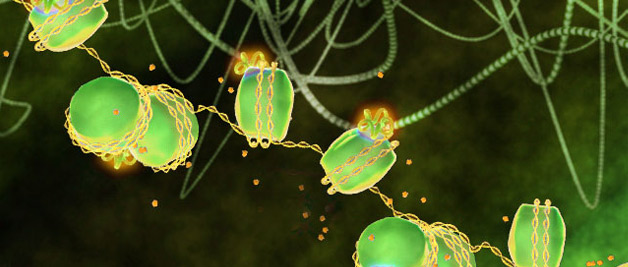
Over the past decade discoveries about the role of epigenetic mechanisms in learning and memory have changed the way scientists think about cognition 1. The most well characterized to date are histone acetylation and DNA methylation, but more recently discovered epigenetic mechanisms are continuing to shape researchers’ understandings of transcriptional regulation in post-mitotic neurons. Chromatin is made up of nucleosomes, which are 147 base pairs of DNA wrapped around a histone octomer. The canonical histones that organize DNA at the level of chromatin are H2A, H2B, H3, and H4, with an additional H1 linker histone connecting individual nucleosomes to each other. These were once thought to be highly stable, but recent discoveries have shown that certain variants of canonical histones- primarily H2A.Z 2 and H3.3 3, cycle with activity in neurons to regulate transcription. How these histone variants contribute to the epigenetic code underlying behavior is an area of active investigation.
Prior work in vitro shows that the histone variant H2A.Z functions in both transcriptional activation and transcriptional repression. H2A.Z localizes to the transcription start site of activity-dependent genes, but is not found in constitutively expressed genes. Upon cellular activation H2A.Z is evicted from these genes, suggesting that H2A.Z primes specific genes for dynamic transcriptional activation 4.
Work from David Sweatt’s group was the first to implicate the histone variant H2A.Z in cognition. They found that in the rodent hippocampus dynamic transcriptional activation after contextual fear conditioning is mediated by H2A.Z eviction immediately downstream of the transcription start site (TSS)2. When H2A.Z levels were depleted via siRNA knockdown they observed an improvement in fear memory, suggesting that H2A.Z is a negative regulator of memory formation. New research from Azad Bonni’s team recently published in the journal Science sheds further light on how this occurs 6. Their findings suggest that H2A.Z is critical for switching off genes after they have been activated by cellular activity.
The Bonni group initially focused on an ATP-dependent chromatin remodeling complex called the nucleosome remodeling and deacetylation (NuRD) complex. They performed ChIP-seq to localize the ATPase subunit of NuRD, Chd4, in mouse cerebellum. At transcription start sites they found that Chd4 occupancy coincided with an epigenetic mark associated with transcriptional activation, H3 lysine 4 trimethylation (H3K4me3), but not with an epigenetic mark associated with transcriptional repression, H3 lysine 27 trimethylation (H3K27me3). Chd4 binding at the TSS was also associated with two additional epigenetic marks detected with a single antibody that are associated with transcriptional activation, H3 lysine 9 and H3 lysine 14 acetylation (H3K9/14ac). They concluded that NuRD binding at transcription start sites occurs at highly transcribed genes.
The researchers looked at histone variant H2A.Z localization and discovered that H2A.Z was present at 97% of the Chd4-bound promoters. With this lead they next performed RNA-seq on the cerebellar tissue of mice with Chd4 conditionally deleted in granule neurons and littermate controls and performed ChIP-seq for H2A.Z to determine how localization of the histone variant correlated to transcription. They discovered that loss of Chd4 leads to a decrease in H2A.Z binding, showing for the first time that the NuRD complex plays a role in H2A.Z incorporation. Their team found that the majority of genes with decreased H2A.Z had higher levels of expression compared to controls. The researchers also noted that there was no difference in H3K9/14ac, H3K4me3, or H3K27me3, which supports a growing body of evidence that histone variant exchange is decoupled from histone post-translational modifications 3. Gene ontology analysis showed that the majority of genes regulated by H2A.Z at the promoter function in intracellular signaling cascades, cell cycle control, and phosphorylation. This suggests that transient signaling in response to cellular activity is mediated by genes containing H2A.Z at the promoter.
To better understand the dynamics of H2A.Z exchange in response to cellular activity they next performed a series of electrophysiology experiments. They found that loss of Chd4 impaired the inactivation of several immediate early genes that are rapidly inactivated one hour after depolarization, but did not impair reactivation. These same genes were also depleted in H2A.Z, suggesting that the NuRD complex loads H2A.Z at promoters to switch off genes that were recently activated by neuronal depolarization. Similarly when they knocked down H2A.Z using RNA interference they found that these same genes were more highly expressed at the time point when they are usually inactivated, but not during initial activation or reactivation.
The researchers next focused their attention to how this mechanism regulates transcription in behavior. They used a cerebellum-dependent motor learning task called the rotating rod (or ‘rotorod’), where rodents must learn to stay on a rotating rod using balance and motor coordination. In line with their results in vitro, they observed that gene expression during activation was unaffected, but one hour after cessation of rotorod activity mice with Chd4 depletion had higher levels of activity-dependent genes than littermate controls. This shows that the NuRD complex regulates gene inactivation in the neurons of the cerebellum governing motor behavior.
This led them to hypothesize that their candidate mechanism may regulate circuit formation in the cerebellum. They used translating ribosomal affinity purification in synchronously developing granule neurons (Sync-TRAP) to see how mRNA translation differed between granule neurons with Chd4 conditionally deleted versus controls. The researchers found higher levels of translation for activity-dependent genes, but not granule neuron specific genes, again supporting a specific role in switching off genes that are transiently activated by cellular activity.
The researchers then asked whether this mechanism regulates dendritic spine morphogenesis. They observed that loss of Chd4 in vivo was associated with longer dendrite length as well as number of primary dendrites during the phase when granule neurons typically undergo dendritic pruning. This suggests that the NuRD complex switches off activity genes to allow dendritic pruning.
To visualize these effects in behaving mice the researchers used two-photon microscopy to image cells in mice trained on a motorized treadmill task. Loss of Chd4 led to a robust increase in the number of neurons activated by running, and a reciprocal decrease in unresponsive neurons. This hyperreponsivity to sensorimotor stimuli led to impairments in multiple tests of procedural learning.
This work is novel because it’s the first paper to show a relationship between the NuRD complex and the histone variant H2A.Z. It also provides new mechanistic insight into the role of H2A.Z by showing that H2A.Z loading at activity-dependent genes is required for their inactivation, and that this mechanism is important in granule cell development and learned procedural behavior. These findings elegantly show how multiple mechanisms work together to give rise to an epigenetic code of transcriptional readout, and provide new information to inform current understandings of neuronal function in health and disease.


